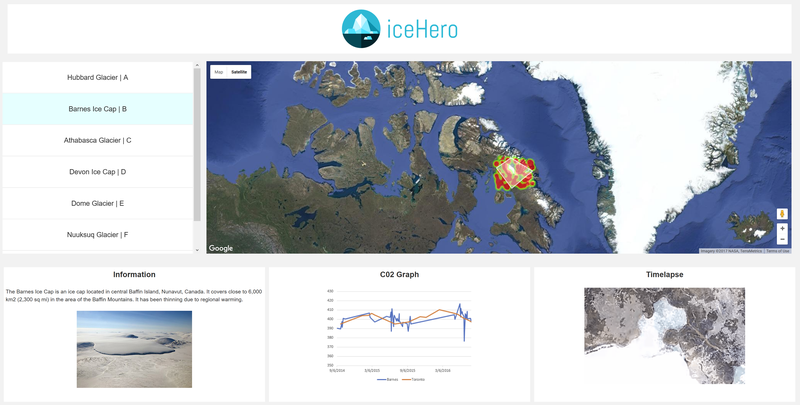hackstreetboys | Our Planet, Our Home
Awards & Nominations
hackstreetboys has received the following awards and nominations. Way to go!
The Challenge | Our Planet, Our Home
iceHero
iceHero is an application for educating the population about the relationship between CO2 emissions and the retreat of glaciers. It also gives scientists a tool to estimate glacier melting rates, when image satellites are unavailable, using CO2 levels.

We designed a simple application that lets the user look at different glaciers across North America and learn about how glacier retreat causes high levels of CO2 emissions. The goal of iceHero is to be a tool for monitoring glacier melt and its relationship on CO2. As a next step, the tool can use aerosol data above glaciers to forecast and predict the rate of glacier melt, which can be used by scientists.
In the application, a user can select from a long list of glaciers. The white overlay tells the user about the general area of where the glacier is located and the red circles display the intensity of CO2 levels in the area. The user is also provided with information about the glacier, a graph comparing CO2 levels in the area with Toronto’s CO2 levels, and a time lapse of glaciers melting recorded from the mid-1980s to the present. Watching these time lapses might have a user ask themselves of where this water is going?
To address this question, the application also highlights various North American cities that are at risk of flooding from rising sea levels caused by glaciers melting.
Looking forward, we would like to grow our application to provide information about glaciers around the world and to link CO2 data to glacier melting rates. Due to the gaps in data experienced by image satellites malfunctioning or not travelling above ice sheets, an alternative method of determining melting rate estimates is necessary. We want iceHero to fill this void. By using CO2 and other aerosol data to forecast melting rates, iceHero would be able to provide interim estimates for scientists to work with while satellites are unavailable.
Link: https://prayashm97.github.io
Github repository : https://github.com/prayashm97/prayashm97.github.io
Presentation Slides: https://docs.google.com/presentation/d/1rF0kOjhzWQ...
Resources used
SkyWatch API : http://www.skywatch.co/
Google Maps API: https://developers.google.com/maps/
Google Earth Engine : https://earthengine.google.com/timelapse/
NSIDC Sea Ice Index: https://nsidc.org/data/seaice_index
Articles:
Another warm month in the Arctic http://nsidc.org/arcticseaicenews/2017/03/another-warm-month-in-the-arctic/
Scientists could end up flying blind about Arctic sea ice at the worst possible time http://mashable.com/2017/03/07/sea-ice-record-low-...
SpaceApps is a NASA incubator innovation program.